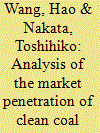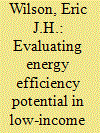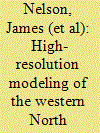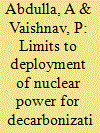|
|
|
Sort Order |
|
|
|
Items / Page
|
|
|
|
|
|
|
| Srl | Item |
| 1 |
ID:
088059


|
|
|
|
|
| Publication |
2009.
|
| Summary/Abstract |
This paper discusses policy instruments for promoting the market penetration of clean coal technologies (CCTs) into China's electricity sector and the evaluation of corresponding effects. Based on the reality that coal will remain the predominant fuel to generate electricity and conventional pulverized coal boiler power plants have serious impacts on environment degradation, development of clean coal technologies could be one alternative to meet China's fast growing demand of electricity as well as protect the already fragile environment. A multi-period market equilibrium model is applied and an electricity model of China is established to forecast changes in the electricity system up to 2030s. Three policy instruments: SO2 emission charge, CO2 emission charge and implementing subsidies are considered in this research. The results show that all instruments cause a significant shift in China's electricity structure, promote CCTs' competitiveness and lead China to gain great benefit in both resource saving and environment improvement. Since resource security and environment degradation are becoming primary concerns in China, policies that could help to gain generations' market share of advanced coal-based technologies such as CCTs' is suitable for the current situation of China's electricity sector.
|
|
|
|
|
|
|
|
|
|
|
|
|
|
|
|
| 2 |
ID:
090079


|
|
|
|
|
| Publication |
2009.
|
| Summary/Abstract |
Electricity sector is among the key users of natural gas. The sustained electricity deficit and environment policies have added to an already rising demand for gas. This paper tries to understand gas demand in future from electricity sector. This paper models the future demand for gas in India from the electricity sector under alternative scenarios for the period 2005-2025, using bottom-up ANSWER MARKAL model. The scenarios are differentiated by alternate economic growth projections and policies related to coal reforms, infrastructure choices and local environment. The results across scenarios show that gas competes with coal as a base-load option if price difference is below US $ 4 per MBtu. At higher price difference gas penetrates only the peak power market. Gas demand is lower in the high economic growth scenario, since electricity sector is more flexible in substitution of primary energy. Gas demand reduces also in cases when coal supply curve shifts rightwards such as under coal reforms and coal-by-wire scenarios. Local environmental (SO2 emissions) control promotes end of pipe solutions flue gas de-sulfurisation (FGD) initially, though in the longer term mitigation happens by fuel substitution (coal by gas) and introduction of clean coal technologies integrated gasification combined cycle (IGCC).
|
|
|
|
|
|
|
|
|
|
|
|
|
|
|
|
| 3 |
ID:
166392


|
|
|
|
|
| Summary/Abstract |
Climate change is likely to affect water availability and therefore hydropower generation in many regions of the world. In drying regions, hydropower generation may be impaired, creating a need for new power investments that would otherwise have been unnecessary. In this study we apply two partial equilibrium models (GCAM and TIAM-ECN) and two general equilibrium models (MEG4C and Phoenix) to identify possible pathways of power sector adaptation for Colombia under climate change. We adopt two GCM projections that deteriorate hydropower generation over the next three decades, and simulate each for two radiative forcing scenarios (RCP8.5 and RCP4.5). Relative to Colombia's projected power demand growth over the coming decades, losses in hydropower generation are marginal. Nonetheless, climate-driven losses in hydropower must be compensated by alternative technologies´expansion, which vary significantly across models. When climate policy is implemented (RCP4.5), three distinct expansion pathways emerge: increased solar and wind energy (TIAM-ECN); significant power demand reductions (Phoenix and MEG4C); and increased fossil resources with carbon dioxide capture and storage (GCAM). We show the need to explore the tradeoffs/synergies among alternative expansion pathways and their potential impacts on other sectors (e.g. water and land), and for effective policies to incentivize their adoption in Colombia.
|
|
|
|
|
|
|
|
|
|
|
|
|
|
|
|
| 4 |
ID:
087081


|
|
|
|
|
| Publication |
Washington, D C, Resources for the Future, Inc, 1973.
|
| Description |
436p.
|
|
|
|
|
|
|
|
|
|
|
|
Copies: C:1/I:0,R:0,Q:0
Circulation
| Accession# | Call# | Current Location | Status | Policy | Location |
| 015012 | 333.7/SEA 015012 | Main | On Shelf | General | |
|
|
|
|
| 5 |
ID:
166459


|
|
|
|
|
| Summary/Abstract |
This study presents a new approach to evaluating energy efficiency potential that provides a more accurate, granular, and flexible estimate of the cost-effective energy efficiency potential in households of various income ranges.
Results from this work estimate that in U.S. single-family households with income less than 200% of the federal poverty level, energy efficiency packages tailored to maximize net present value could result in an estimated $13 billion per year in energy cost savings, or $670 per year for an average household, corresponding to about 1 EJ (0.9 quads) of annual primary energy savings. These types of metrics can be estimated for other geographies (regions, states, and counties) and for other ranges of household income.
|
|
|
|
|
|
|
|
|
|
|
|
|
|
|
|
| 6 |
ID:
150431


|
|
|
|
|
| Summary/Abstract |
The after-market roof rack is one of the most common components attached to a vehicle for carrying over-sized items, such as bicycles and skis. It is important to understand these racks’ fuel consumption impacts on both individual vehicles and the national fleet because they are widely used. We estimate the national fuel consumption impacts of roof racks using a bottom-up approach. Our model incorporates real-world data and vehicle stock information to enable assessing fuel consumption impacts for several categories of vehicles, rack configurations, and usage conditions. In addition, the model draws on two new data-gathering techniques, on-line forums and crowd-sourcing. The results show that nationwide, roof racks are responsible for 0.8‰ of light duty vehicle fuel consumption in 2015, corresponding to 100 million gallons of gasoline per year. Sensitivity analyses show that results are most sensitive to the fraction of vehicles with installed roof racks but carrying no equipment. The aerodynamic efficiency of typical roof racks can be greatly improved and reduce individual vehicle fuel consumption; however, government policies to minimize extensive driving with empty racks—if successful—could save more fuel nationally.
|
|
|
|
|
|
|
|
|
|
|
|
|
|
|
|
| 7 |
ID:
112271


|
|
|
|
|
| Publication |
2012.
|
| Summary/Abstract |
Decarbonizing electricity production is central to reducing greenhouse gas emissions. Exploiting intermittent renewable energy resources demands power system planning models with high temporal and spatial resolution. We use a mixed-integer linear programming model - SWITCH - to analyze least-cost generation, storage, and transmission capacity expansion for western North America under various policy and cost scenarios. Current renewable portfolio standards are shown to be insufficient to meet emission reduction targets by 2030 without new policy. With stronger carbon policy consistent with a 450 ppm climate stabilization scenario, power sector emissions can be reduced to 54% of 1990 levels by 2030 using different portfolios of existing generation technologies. Under a range of resource cost scenarios, most coal power plants would be replaced by solar, wind, gas, and/or nuclear generation, with intermittent renewable sources providing at least 17% and as much as 29% of total power by 2030. The carbon price to induce these deep carbon emission reductions is high, but, assuming carbon price revenues are reinvested in the power sector, the cost of power is found to increase by at most 20% relative to business-as-usual projections.
|
|
|
|
|
|
|
|
|
|
|
|
|
|
|
|
| 8 |
ID:
150777


|
|
|
|
|
| Summary/Abstract |
Decision making in Iran's energy and environment-related issues has always been tied to complexities. Discussing these complexities and the necessity to deal with them, this paper strives to help the country with a tool by introducing Richest Alternatives for Implementation to Supply Energy (RAISE), a mixed integer linear programming model developed by the means of GNUMathprog mathematical programming language. The paper fully elaborates authors' desired modeling mentality and formulations on which RAISE is programmed to work and verifies its structure by running a widely known sample case named “UTOPIA” and comparing the results with other works including OSeMOSYS and Temoa. The model applies RAISE model to Iranian energy sector to elicit optimal policy without and with a CO2 emission cap. The results suggest promotion of energy efficiency through investment on combined cycle power plants as the key to optimal policy in power generation sector. Regarding oil refining sector, investment on condensate refineries and advanced refineries equipped with Residual Fluid Catalytic Cracking (RFCC) units are suggested. Results also undermine the prevailing supposition that climate change mitigation deteriorates economic efficiency of energy system and suggest that there is a strong synergy between them. In the case of imposing a CO2 cap that aims at maintaining CO2 emissions from electricity production activities at 2012 levels, a shift to renewable energies occurs.
|
|
|
|
|
|
|
|
|
|
|
|
|
|
|
|
| 9 |
ID:
166518


|
|
|
|
|
| Summary/Abstract |
Decarbonization will require deployment of low-carbon technologies, but analysts have struggled to quantify which ones could be deployed in practice—especially where technologies have faced public opposition. For nuclear power, some analysts have tried to solve this problem with caps on deployment or nuclear-free scenarios; however, social science research has not offered nuanced guidance about these caps. We deploy an experiment involving a large U.S. sample (N = 1226) to disentangle public opposition due to the dread of nuclear power from opposition stemming from its actuarial risk. Respondents are asked to build a power generation portfolio that cuts CO2 emissions, given information about the actuarial risks of technologies. Half the sample is exposed to the nuclear power label while the other half is treated with the risk information but blinded to the label. Respondents who see the labels deploy 6.6 percentage points less nuclear power as a share of the U.S. electricity mix. Our results suggest that dread about nuclear power leads respondents to choose 40% less nuclear generation in 2050 than they would have chosen in the absence of this dread. These methods could apply to other technologies, such as carbon storage, where there may be gaps between actuarial and perceived risks.
|
|
|
|
|
|
|
|
|
|
|
|
|
|
|
|
| 10 |
ID:
150039


|
|
|
|
|
| Summary/Abstract |
Implicit discount rates (IDRs) are employed in energy models to capture household investment decisions, yet the factors behind the IDR and their respective implications for policy-making usually remain blurred and fractional. The proposed comprehensive framework distinguishes three broad categories of factors underlying the IDR for household adoption of energy-efficient technologies (EETs): preferences (notably over time, risk, loss, debt, and the environment), predictable (ir)rational behavior (bounded rationality, rational inattention, behavioral biases), and external barriers to energy efficiency. Existing empirical findings suggest that the factors underlying the IDRs that differ across household characteristics and technologies should be accounted for in energy models. Furthermore, the framework allows for a fresh look at the interplay of IDRs and policies. We argue that a simple observation of high IDRs (or observing correlations between IDRs and socio-economic characteristics) does not provide guidance for policy-making since the underlying sources cannot be identified. Instead, we propose that some of the factors underlying the IDR - notably external barriers - can be changed (through directed policy interventions) whereas other factors - notably preferences and predictable (ir)rational behavior - are innate and can only be taken into account (through reactive policy interventions).
|
|
|
|
|
|
|
|
|
|
|
|
|
|
|
|
| 11 |
ID:
109616


|
|
|
|
|
| Publication |
2011.
|
| Summary/Abstract |
This paper discusses the design and development of the Open Source Energy Modeling System (OSeMOSYS). It describes the model's formulation in terms of a 'plain English' description, algebraic formulation, implementation-in terms of its full source code, as well as a detailed description of the model inputs, parameters, and outputs. A key feature of the OSeMOSYS implementation is that it is contained in less than five pages of documented, easily accessible code. Other existing energy system models that do not have this emphasis on compactness and openness makes the barrier to entry by new users much higher, as well as making the addition of innovative new functionality very difficult. The paper begins by describing the rationale for the development of OSeMOSYS and its structure. The current preliminary implementation of the model is then demonstrated for a discrete example. Next, we explain how new development efforts will build on the existing OSeMOSYS codebase. The paper closes with thoughts regarding the organization of the OSeMOSYS community, associated capacity development efforts, and linkages to other open source efforts including adding functionality to the LEAP model.
|
|
|
|
|
|
|
|
|
|
|
|
|
|
|
|
| 12 |
ID:
193747


|
|
|
|
|
| Summary/Abstract |
Decarbonizing road transport – through electrification, public transport, and walking and biking – can be a net social benefit thanks to reduced congestion, accidents, air pollution, and energy costs. However, governments face losing fuel and vehicle tax revenue. We develop for the first time a method to assess options to maintain fiscal revenues without hampering decarbonization benefits for firms and households. We estimate the financial impact of transport decarbonization on the government, firms (buses, taxis, freight, and other private uses), and households grouped by income level and region of residence. Then, we evaluate how the government can use energy, property, import, and distance-based tax adjustments to compensate for the fiscal cost of decarbonization, and the incidence of these adjustments on firms and households. We apply the method to Costa Rica, a country committed to reaching net-zero emissions by 2050 and where 20% of government revenue comes from transport taxes. Decarbonizing transport would cause a fiscal impact of −0.41% of GDP on average between 2023–50, which is lower than the financial benefits on households and firms: +1.49% of GDP. We show that a combination of tax adjustments would eliminate the fiscal impact while maintaining net benefits for all firms and households of all income levels and regions of residence.
|
|
|
|
|
|
|
|
|
|
|
|
|
|
|
|
| 13 |
ID:
191400


|
|
|
|
|
| Summary/Abstract |
The use of green hydrogen can support the decarbonization of sectors which are difficult to electrify, such as industry or heavy transport. Yet, the wider power sector effects of providing green hydrogen are not well understood so far. We use an open-source electricity sector model to investigate potential power sector interactions of three alternative supply chains for green hydrogen in Germany in the year 2030. We distinguish between model settings in which Germany is modeled as an electric island versus embedded in an interconnected system with its neighboring countries, as well as settings with and without technology-specific capacity bounds on wind energy. The findings suggest that large-scale hydrogen storage can provide valuable flexibility to the power system in settings with high renewable energy shares. These benefits are more pronounced in the absence of flexibility from geographical balancing. We further find that the effects of green hydrogen production on the optimal generation portfolio strongly depend on the model assumptions regarding capacity expansion potentials. We also identify a potential distributional effect of green hydrogen production at the expense of other electricity consumers, of which policy makers should be aware.
|
|
|
|
|
|
|
|
|
|
|
|
|
|
|
|
| 14 |
ID:
150427


|
|
|
|
|
| Summary/Abstract |
Space heating energy consumption in urban residential areas of the hot summer and cold winter zones (HSCW) in China has increased dramatically during the last decade. Large-scale surveys and in-depth measurements of residential heating consumption is important to monitor trends. More importantly, a macro energy model that reflects the current status and that can be used to analyze future scenarios is needed. In this paper, a bottom-up model was established, and the results show the total energy consumption in the HSCW and the influences of building envelops, heating equipment efficiency, and especially occupant behavior on energy use. Related technical and policy suggestions were analyzed in different scenarios. Presently, energy consumption for heating in urban residential areas of the HSCW is relatively low, but is increasing rapidly, so the establishment of superior national building energy efficient designs requires attention. The findings suggest that the district heating network would not be feasible for the HSCW and decentralized heating should be the major heating method employed. Besides building efficiency, appliance efficiency should also be improved. Lastly, residents' behaviors in regards to the opening of windows can significantly influence energy use and should be carefully considered by policy makers and engineers.
|
|
|
|
|
|
|
|
|
|
|
|
|
|
|
|
|
|
|
|
|